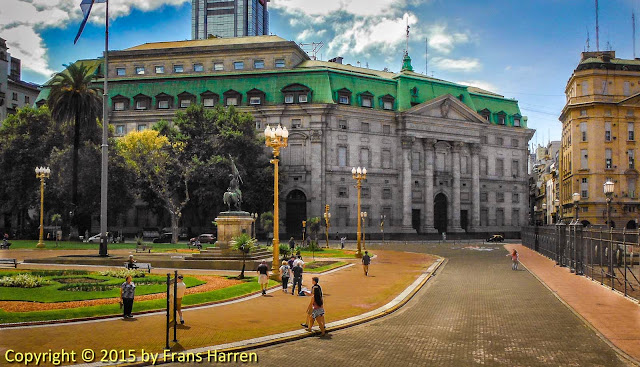
Headquarters of the Bank of the Argentine Nation
The Headquarters of the Bank of the Argentine Nation, more often referred locally as Banco Nación Casa Central, is a monumental bank building next to the Plaza de Mayo, founding site of Buenos Aires and host of major events in the history of the country.
Designed by renowned Argentine architect Alejandro Bustillo in a Neoclassical style with French influences, the 100,000 m2 building occupies an entire city block and was inaugurated in 1944.
With a dome 50 m in diameter, the building is a National Historic Landmark.
History
The headquarters are located in the San Nicolás neighborhood of Buenos Aires on the site of the Teatro Colón's first building, bought by the national government in 1888 and later designated as main offices of the recently founded national bank. The edifice was remodeled in 1910 by architect Adolfo Büttner to better suit its new role.
In 1938 Alejandro Bustillo presented a new design for a much larger, 100,000 m2 structure, which was built in two stages between 1940 and 1955.
See: wikipedia
Banco de la Nación Argentina
Bank of the Argentine Nation is the national bank of Argentina, and the largest in the country's banking sector.
History
The Bank of the Argentine Nation was founded on 18 October 1891 by President Carlos Pellegrini, with the purpose of stabilizing the nation's finances following the Panic of 1890; its first director was Vicente Lorenzo Casares. In its early decades it became a leading financing source for agricultural smallholders, and later for commercial and industrial businesses, as well as handling an array of public sector transactions.
The bank's reputation suffered after it was revealed that bribes had been received by the board of directors in 1994 when contacting IBM for the supply of computers, software, and communication equipment, becoming a prominent political scandal at the time.
See: wikipedia
Buenos Aires
Buenos Aires is the capital and largest city of Argentina, and the second-largest metropolitan area in South America, after Greater São Paulo. It is located on the western shore of the estuary of the Río de la Plata, on the continent's southeastern coast. The Greater Buenos Aires conurbation, which also includes several Buenos Aires Province districts, constitutes the third-largest conurbation in Latin America, with a population of around fifteen and a half million.
The city of Buenos Aires is neither part of Buenos Aires Province nor the Province's capital; rather, it is an autonomous district. In 1880, after decades of political infighting, Buenos Aires was federalised and removed from Buenos Aires Province. The city limits were enlarged to include the towns of Belgrano and Flores; both are now neighborhoods of the city. The 1994 constitutional amendment granted the city autonomy, hence its formal name: Ciudad Autónoma de Buenos Aires (Autonomous City of Buenos Aires). Its citizens first elected a Chief of Government (i.e. Mayor) in 1996; before, the Mayor was directly appointed by the President of the Republic.
Buenos Aires is, along with Mexico City and São Paulo, one of the three Latin American cities considered an 'alpha city' by the study GaWC5. Buenos Aires, Argentina has the third best quality of life of Latin American cities. Buenos Aires' quality of life is ranked 81st in the world, with its per capita income among the three highest in the region. It is the most visited city in South America (ahead of Rio de Janeiro) and the second most visited city across Spanish Latin America (behind Mexico City). It is also one of the most important, largest and most populous of South American capitals, often referred to as the Paris of South America.
Buenos Aires is a top tourist destination, and is known for its European-style architecture and rich cultural life, with the highest concentration of theatres in the world. Buenos Aires held the 1st Pan American Games in 1951 and the city also had two venues in the 1978 FIFA World Cup. Buenos Aires will host the 2018 Summer Youth Olympics.
People from Buenos Aires are referred to as porteños (people of the port). The city is the birthplace of pope Francis (former Archbishop of Buenos Aires), and Queen Máxima of the Netherlands.
See: wikipedia











0 comments:
Post a Comment